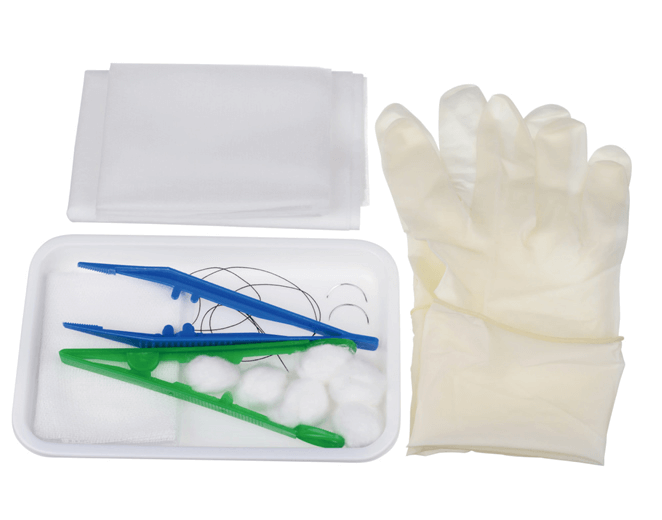Disposable Dressing Pack: An Essential Tool in Wound Care
2025-05-07
A disposable dressing pack is a vital component in modern wound care, providing all the necessary materials required to manage and treat wounds in a sterile and effective manner. Whether used in hospitals, clinics, or at home, disposable dressing packs ensure the prevention of infection and promote the healing process. This article delves into the purpose, contents, types, and benefits of disposable dressing packs, shedding light on their importance in healthcare.

What Is a Disposable Dressing Pack?
A disposable dressing pack is a pre-packaged collection of sterile supplies designed for wound care. These packs are used for the treatment of minor cuts, abrasions, surgical incisions, and other types of wounds. By ensuring that all materials remain sterile until used, these packs prevent contamination and reduce the risk of infection during the healing process.
These packs are single-use, meaning they are discarded after one application, ensuring the materials are always clean and sterile. The packs are commonly used by healthcare professionals and individuals who need to manage a wound in a safe and hygienic manner.
Common Contents of a Disposable Dressing Pack
A typical disposable dressing pack contains several essential components that are required for proper wound care. While the specific contents may vary depending on the manufacturer or the specific use, the following are the most common items found in a basic dressing pack:
1. Sterile Gauze Pads: Used for covering the wound, absorbing exudate, and maintaining a clean environment. Gauze pads help prevent contamination and provide cushioning for the wound site.
2. Adhesive Dressings: These are used to hold the gauze or other dressing materials in place, ensuring that the wound is properly covered and protected from dirt and bacteria.
3. Sterile Swabs: These are used for cleaning the wound area or applying antiseptic solutions. Swabs are useful for cleaning small areas and ensuring the wound site remains sterile before applying the dressing.
4. Antiseptic Solution or Wipes: An antiseptic solution, such as iodine or alcohol wipes, is included to clean the wound site and remove any bacteria or dirt before applying the dressing.
5. Adhesive Tape: Used to secure the dressing in place. The tape ensures that the dressing stays in position and does not shift, which could expose the wound to external contaminants.
6. Disposable Gloves: These are included to ensure that the person applying the dressing does so without direct contact with the wound, reducing the risk of cross-contamination.
7. Plastic or Waterproof Covering: Sometimes, a plastic sheet is included in the pack to cover the dressing and ensure that the wound remains dry, especially in areas exposed to moisture or water.
8. Scissors (Optional): In some packs, small scissors are provided to cut the dressing materials to the appropriate size for the wound.
Types of Disposable Dressing Packs
There are various types of disposable dressing packs, tailored to specific needs and situations. Some of the most common types include:
1. Basic Dressing Packs: These are general-purpose packs that contain all the basic items for simple wound care. They are ideal for minor cuts, abrasions, and small surgical wounds.
2. Surgical Dressing Packs: Designed specifically for surgical procedures, these packs may contain additional sterile instruments and more advanced materials for managing surgical incisions or more significant wounds.
3. Burn Dressing Packs: These packs contain materials suited for the treatment of burns, such as sterile burn dressings, hydrocolloid dressings, and burn gels that promote faster healing and pain relief.
4. Eye Dressing Packs: Specifically designed for eye injuries or surgeries, these packs contain materials that are gentle enough for the delicate eye area. They may include sterile eye pads and a mild antiseptic solution.
5. Incontinence Dressing Packs: These packs are designed for individuals who need specialized wound care due to incontinence-related issues, providing materials to manage skin irritation or ulcers.
Benefits of Disposable Dressing Packs
There are several benefits to using disposable dressing packs for wound care:
1. Sterility and Infection Prevention: One of the primary advantages of using a disposable dressing pack is its ability to maintain sterility. Since the contents are packaged in a sealed, sterile environment, the risk of infection is minimized.
2. Convenience and Time-Saving: Disposable dressing packs are pre-assembled with all the necessary materials, which saves time for both healthcare providers and individuals at home. There’s no need to search for separate items, making the treatment process quicker and more efficient.
3. Consistency in Wound Care: The contents of the pack are standardized, ensuring that each dressing is applied in a consistent manner. This reduces the chances of errors and ensures that wound care is effective and reliable every time.
4. Ease of Use: Disposable dressing packs are designed to be user-friendly, making them suitable for both healthcare professionals and individuals without medical training. This ensures that wound care can be easily carried out, even in home or emergency settings.
5. Minimizes Cross-Contamination: Since the items are individually wrapped and sterile until use, disposable dressing packs help minimize the risk of cross-contamination. This is particularly important in preventing the spread of infections in healthcare settings.
6. Cost-Effective: Disposable dressing packs are affordable, especially when compared to buying individual components separately. Hospitals, clinics, and home users benefit from the cost-effectiveness of purchasing pre-packaged sets.
7. Hygienic and Safe Disposal: As these dressing packs are disposable, they eliminate the need to clean and reuse items, ensuring a higher standard of hygiene. Once used, all components can be safely discarded, reducing the risk of contamination.
How to Use a Disposable Dressing Pack
Using a disposable dressing pack properly is essential for achieving the best results in wound care. Follow these general steps for effective application:
1. Wash Your Hands: Always begin by washing your hands thoroughly to reduce the risk of transferring bacteria to the wound.
2. Put on Disposable Gloves: Wearing gloves ensures that you don’t directly touch the wound, minimizing the chance of infection.
3. Clean the Wound: Use the antiseptic wipes or solution included in the pack to clean the wound area. Gently wipe away any dirt or debris without irritating the wound.
4. Apply the Dressing: Place the sterile gauze or dressing over the wound. If necessary, secure the dressing in place with adhesive tape.
5. Dispose of the Materials: Once the dressing has been applied, carefully dispose of all used items in a proper waste container.
Conclusion
A disposable dressing pack is an indispensable tool in wound care, providing an efficient, sterile, and convenient way to treat various types of wounds. Whether used for minor cuts, surgical incisions, or burns, these packs ensure that the wound is kept clean, protected, and free from infection. By using the right materials and following proper techniques, individuals can effectively manage wounds, promote healing, and reduce the risk of complications.


